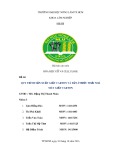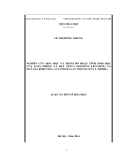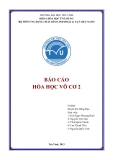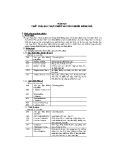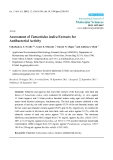Annals of Intensive Care
This Provisional PDF corresponds to the article as it appeared upon acceptance. Fully formatted PDF and full text (HTML) versions will be made available soon.
Intrahospital transport of critically ill patients (excluding newborns) Recommendations of the Societe de Reanimation de Langue Francaise (SRLF), the Societe Francaise d'Anesthesie et de Reanimation (SFAR), and the Societe Francaise de Medecine d'Urgence (SFMU)
Annals of Intensive Care 2012, 2:1 doi:10.1186/2110-5820-2-1
Jean-Pierre Quenot (jean-pierre.quenot@chu-dijon.fr) Christophe Milesi (c-milesi@chu-montpellier.fr) Aurely Cravoisy (a.cravoisy@chu-nancy.fr) Gilles Capellier (gilles.capellier@univ-fcomte.fr) Olivier Mimoz (o.mimoz@chu-poitiers.fr) Olivier Fourcade (fourcade.o@chu-toulouse.fr) Pierre-Yves Gueugniaud (pierre-yves.gueugniaud@chu-lyon.fr)
ISSN 2110-5820
Article type Review
Submission date 2 December 2011
Acceptance date 3 February 2012
Publication date 3 February 2012
Article URL http://www.annalsofintensivecare.com/content/2/1/1
This peer-reviewed article was published immediately upon acceptance. It can be downloaded, printed and distributed freely for any purposes (see copyright notice below).
Articles in Annals of Intensive Care are listed in PubMed and archived at PubMed Central.
For information about publishing your research in Annals of Intensive Care go to
http://www.annalsofintensivecare.com/authors/instructions/
For information about other SpringerOpen publications go to
© 2012 Quenot et al. ; licensee Springer. This is an open access article distributed under the terms of the Creative Commons Attribution License (http://creativecommons.org/licenses/by/2.0), which permits unrestricted use, distribution, and reproduction in any medium, provided the original work is properly cited.
http://www.springeropen.com
Intrahospital transport of critically ill patients (excluding newborns)
Recommendations of the Société de Réanimation de Langue Française (SRLF),
the Société Française d’Anesthésie et de Réanimation (SFAR), and the Société
Française de Médecine d’Urgence (SFMU)
1Service de Réanimation Médicale, CHU Bocage Central Gabriel, 14 rue Paul Gaffarel, 21 079
Jean-Pierre Quenot*1, Christophe Milési2, Aurély Cravoisy3, Gilles Capellier4, Olivier Mimoz5, Olivier Fourcade6 and Pierre-Yves Gueugniaud7
2Service de Réanimation Pédiatrique, CHU Lapeyronie, 371 avenue du doyen Gaston Giraud,
Dijon, France
3Service de Réanimation Médicale, CHU Hôpital Central, 29, avenue du Maréchal de Lattre de
34 295 Montpelier, France
4Service de Réanimation Médicale, CHU Hôpital Jean Minjoz, 3, Boulevard Fleming, 25 000
Tassigny, 54 035 Nancy, France
5Service d’Anesthésie Réanimation, CHU de la Milétrie, 2 rue de la Milétrie, 86 021 Poitiers,
Besançon, France
6Pôle Anesthesie Réanimation, CHU pavillon urgences et réanimation, Hôpital Purpan, place du
France
7Service Aide Médicale Urgente, CHU hospices civils, 162, avenue Lacassagne, 69 003 Lyon,
Docteur Baylac, 31 059 Toulouse, France
France
*Corresponding author: jean-pierre.quenot@chu-dijon.fr
Email addresses:
JPQ: jean-pierre.quenot@chu-dijon.fr
CM: c-milesi@chu-montpellier.fr
AC: a.cravoisy@chu-nancy.fr
GC: gilles.capellier@univ-fcomte.fr
OM: o.mimoz@chu-poitiers.fr
OF: fourcade.o@chu-toulouse.fr
PYG: pierre-yves.gueugniaud@chu-lyon.fr
2
Abstract Critically ill adult patients often require multiple examinations in the hospital and need transport
from one department to another, or even between hospitals. However, to date, no guidelines exist
regarding optimum practices for transport of these fragile patients. We present recommendations for
intrahospital transport of critically ill patients, excluding newborns, developed by an expert group
of the French-Language Society of Intensive Care (Société de Réanimation de Langue Française
(SRLF)). The recommendations cover five fields of application: epidemiology of adverse events;
equipment, monitoring, and maintenance; preparation of patient before transport; human resources
and training for caregivers involved in transport processes; and guidelines for planning, structure,
and traceability of transport processes.
Keywords: intrahospital transport; critical care; adults.
3
Introduction and methodology of the expert recommendations
These recommendations were developed by a Working Group brought together at the initiative of
the French-Language Society of Intensive Care (Société de Réanimation de Langue Française
(SRLF)). The experts comprising this group wrote a background text justifying each of the five
fields of application that were previously defined by the Organizing Committee. The
recommendations for pediatric patients were included in the relevant fields alongside the
recommendations for adults. These expert recommendations constitute a contribution to the
standard risk evaluation protocol and to the quality of care improvement program elaborated by
professional societies in our discipline. The recommendations are mainly based on data from
prospective or retrospective observational studies and international consensus documents. The
recommendations are proposed and discussed individually, with each expert (or expert subgroup)
obliged to provide scientific evidence to justify the basis for the recommendation, as well as the
level of recommendation, each of which was subject to modification according to the remarks made
by the rest of the expert group. In a second phase, the recommendations were graded by the whole
expert group. The objective was not necessarily to arrive at a single consensus on the level and
grade of recommendation for all the guidelines but rather to clearly identify areas where opinions
converged, which would be the basis for the recommendations, as well as areas where disagreement
persisted, which could be the object of further research.
Each recommendation was graded by each expert according to the RAND/UCLA appropriateness
rating method, using repeated rounds of grading after exclusion of the extreme values (highly
deviant expert ratings). Each expert graded recommendations based on a scale from 1 to 9 (with 1
corresponding to the existence of “total disagreement,” “absence of proof,” or “formal
contraindication” and 9 corresponding to “total agreement,” “formal proof,” or “formal indication”).
Three zones were defined according to the location of the median score: 1–3 corresponds to the
disagreement zone; 4–6 to the zone of indecision; and 7–9 to the agreement zone. The level of
4
agreement, indecision, or disagreement is considered to be “strong” if the median falls within the
boundaries of the corresponding zone. If the medial overlaps with a boundary (e.g., interval from 1–
4 or 6–8), then the agreement (or disagreement) is considered to be weak. The methodology for this
document is based on the GRADE method (http://www.gradeworkinggroup.org//links.htm).
The originality of the GRADE system resides in the following elements: the type of study design
(i.e., randomized, controlled trials, or not) alone is not sufficient to attribute a level of evidence; the
actual risk-benefit ratio is taken into account, and finally, recommendations are formulated clearly
and unambiguously for users (we recommend / we do not recommend; we suggest / we do not
suggest).
Field 1
Epidemiology of adverse events related to patients and their environment: general taxonomy
1) Critically ill patients, whether or not they are hospitalized in critical care, frequently require
intrahospital transport (IHT) for diagnostic or therapeutic procedures, or for admission to a
specialized care unit. Strong Agreement.
2) Critically ill patients include all patients presenting with dysfunction or failure or one or more
vital organs or systems. Strong Agreement.
3) It is necessary to standardize the definitions of adverse events (AE) and their avoidance during
IHT. Strong Agreement.
4) Adverse events are classified into two categories, according to their seriousness: serious adverse
events (SAEs), and high-risk events (HREs). Strong Agreement.
5
5) An SAE is a complication directly related to patient care that can lead to a life-threatening
situation, longer hospital stay, need for invasive procedures, or have serious consequences. Strong
Agreement.
6) High-risk events are defined by current legislation for the accreditation of physicians practicing
in at-risk disciplines. They cover all adverse events that are not SAE, i.e., minor adverse events and
dysfunctions in equipment or organization of care. Strong Agreement.
7) Minor incidents without major consequences regularly occur during transport. Therefore, it is
necessary to define the most common SAE and HRE to implement monitoring and corrective
measures. Strong Agreement.
8) Adverse events that occur during transport and require curative therapeutic intervention must be
considered SAEs. Strong Agreement.
9) Adverse events that occur during transport and require therapeutic intervention that does not
succeed in correcting the situation according to the objectives laid down by the clinician must be
considered as SAEs. Strong Agreement.
10) A HRE complicated by auto-extubation and/or cardiac arrest is a SAE. Strong Agreement.
11) Oxygen desaturation that requires an increase of fractional inspired oxygen (FIO2) or any other
change in ventilator settings is considered a HRE. This should be considered a SAE if the situation
remains uncorrected or does not reach the target set by the clinician. Strong Agreement.
6
12) A decrease in blood pressure that requires therapeutic intervention is a HRE. This should be
considered a SAE if treatment does not reach the target set by the clinician. Strong Agreement.
13) A state of agitation or when the patient is not synchronized to the ventilator, a state that requires
therapeutic intervention is considered a HRE. This should be considered a SAE if the situation
remains uncorrected by the therapeutic intervention. Strong Agreement.
14) Any ventilator-related event that requires a change in ventilatory settings, ventilation with
manual resuscitator (bag valve mask), or a change of equipment is considered a HRE. Strong
Agreement.
15) Any ventilator-related event complicated by a clinical event is considered a SAE. Strong
Agreement.
16) Disconnection of equipment (catheters, drains, intracranial pressure wires…) are considered
HREs when they have no direct clinical consequences. They must be considered SAEs if a
complication occurs. Strong Agreement.
17) An adverse event that occurs during IHT must be considered unavoidable when the entire
transport process was performed in conformity with standard protocol. Strong Agreement.
18) Safety practices are any healthcare, structural, or organizational practices that contribute to
preventing, reducing the frequency of, or attenuating the consequences of errors and adverse events
during IHT. Strong Agreement.
7
19) Any adverse event that occurs during IHT should be notified for subsequent analysis. Strong
Agreement.
Field 2
Equipment, monitoring and maintenance
1) The choice of equipment should take into account its bulk and autonomy. Strong Agreement.
2) All connections between the various monitors (e.g., invasive pressure wires) should be checked
thoroughly before IHT. Strong Agreement.
3) The minimum monitoring required during IHT includes ECG heart rate monitoring, pulse
oximetry, and noninvasive blood pressure monitoring. Strong Agreement.
4) In nonventilated patients, ventilatory rate should be monitored at regular intervals, ideally with
continuous monitoring. Strong Agreement.
5) End-tidal CO2 (ET CO2) monitoring is recommended for patients with neurological disorders and
for patients in whom strict control of partial pressure of CO2 (PaCO2) is required. Strong
Agreement.
6) The main parameters being monitored should be associated with alarms whose settings can be
adapted in each patient. Strong Agreement.
7) Special equipment should be available, dedicated to IHT, and clearly identified within each
healthcare establishment, department, or division. Strong Agreement.
8
8) Ventilators used for transport should be equipped with visual or audible alarms for the main
ventilatory parameters being monitored. Strong Agreement.
9) For ventilated patients undergoing transport that could be of long duration, or in patients at
particularly high risk, a suction system should be immediately available, ideally in the form of a
portable electric suction device. Strong Agreement.
10) The autonomy of all devices, in terms of electricity and medical gas supply, should be adapted
to the estimated duration of IHT and rate of consumption, which can vary depending on usage, and
reserves should be monitored. Strong Agreement.
11) Monitoring equipment should be adapted to the type of transport, patient risk, and ongoing
therapy, and based on a written protocol. Strong Agreement.
12) Manual ventilation with a manual resuscitator (bag valve mask) during IHT should be avoided
and only used in case of failure of the ventilator (including in children). Strong Agreement.
13) The settings on portable ventilators for use during transport should allow for the same
ventilatory parameters as the ICU ventilator, including noninvasive ventilation modes. Strong
Agreement.
14) At all times during transport, it should be possible, in ventilated patients, to switch immediately
from ventilation to manual ventilation through an endotracheal tube or mask. Strong Agreement.
15) The exact capacities of the portable ventilator for use during transport should be known to the
user. There are three categories. Strong Agreement.
9
- Basic or emergency ventilators (volume-control (VC) mode, positive end-expiratory
pressure (PEEP), reduced monitoring)
- Intermediate ventilator (volume assist control (VAC), PEEP, adjustable flow or I:E ratio,
spirometry), FiO2 setting at 100% or air/oxygen mix
- High-performance ventilator (volumetric and barometric ventilation modes, including
spontaneous mode and assist control, PEEP, wide range of settings for FiO2, adjustable inspiratory
flow, appropriate triggers, spirometry, ideally with circuit compliance compensation and non-
invasive ventilation (NIV) mode).
16) The functions, monitoring, and alarms on the ventilator should be adapted to the patient’s
condition. Strong Agreement.
A. Very hypoxemic patient (e.g., acute respiratory distress syndrome): high-performance -
ventilator
- B. Patient requiring strict control of PaCO2: intermediate or high-performance ventilator
C. Patient-triggered ventilation (assist modes): intermediate or high-performance ventilator -
D. Patients under noninvasive ventilation: Ventilator with a high-performance NIV mode -
17) The type of electric supply and recharging capabilities of the ventilator must be compatible with
use at all times and should have sufficient electricity reserves to perform the planned IHT. Strong
Agreement.
18) The ventilator used for IHT must have an audible alarm to signal interruption of gas or
electricity supply, or ventilator failure. Strong Agreement.
10
19) The interface of the portable ventilator used for transport should not allow for any accidental
disturbances to the ventilator settings. Strong Agreement.
20) At equal performance levels. Strong Agreement
- The ventilator with the simplest user interface should be given precedence.
- The ventilator with the simplest patient circuit should be given precedence.
21) To check that tolerance of the portable ventilator and patient stability are adequate, the portable
ventilator should be connected to the patient 5 to 10 minutes before leaving the patient’s room,
using the wall gas supply and the mains electricity supply. Strong Agreement.
22) The portable ventilator should be stored in an easily accessible place that is known to all
potential users and with all accessories: complete patient circuit kit with heat and moisture
exchanger (HME) and corrugated tube, gas supply tube. Strong Agreement.
23) The circuit used should be in accordance with manufacturer’s recommendations. Strong
Agreement.
24) Where necessary, the ventilator tubes used should be adapted to the characteristics of the
ventilator. Strong Agreement.
25) To ensure adequate humidification of the patient’s airways and protection of the ventilator, an
antibacterial filter and HME should be systematically put in place between the corrugated tube and
the patient circuit. Strong Agreement.
11
26) The machine settings and alarms for the portable ventilator must be specified on a written
prescription. Strong Agreement.
27) Ventilation monitoring by the portable ventilator should comprise, as a minimum requirement,
monitoring of inspiratory pressure with display of the peak pressure and spirometry. Strong
Agreement.
28) Self- or accidental extubation must be detected immediately by monitoring of capnography
and/or spirometry. Strong Agreement.
29) Analysis of the expiratory phase of the capnogram can help to identify certain complications of
ventilation during transport. Strong Agreement.
30) In synchronous intermittent mandatory ventilation (SIMV) mode, the portable ventilator should
be equipped with the necessary general requirements in terms of performance and monitoring to
guarantee appropriate ventilation. Strong Agreement.
31) Certain models of portable ventilator claim to be equipped with SIMV mode but in actual fact
do not really provide this mode of ventilation. These ventilators should not be used. Strong
Agreement.
32) Continuous positive airway pressure (CPAP) mode is suboptimal on ventilators and consumes
large amounts of oxygen. Strong Agreement.
33) An invasive device for continuous measurement of blood pressure must be used during IHT if
the patient is under treatment with vasoactive agents and/or hemodynamically unstable, and if the
12
patient already has continuous invasive blood pressure monitoring in the hospital before IHT.
Strong Agreement.
34) Monitoring of central venous pressure is not recommended during IHT. Strong Agreement.
35) A defibrillator–pacemaker must be easily available during transport. Ideally, it should be
integrated with a multiparameter monitor. Strong Agreement.
36) If the patient is dependent on an external pacemaker, the thresholds of the pacemaker must be
verified and adapted, and the battery should be checked. A spare external pacemaker must be
available during transport. Strong Agreement.
37) In the presence of temporary pacing wires, a portable pacemaker must be used. Strong
Agreement.
38) A written protocol must be put in place to plan for the immediate replacement of any defective
or missing equipment. Strong Agreement.
39) The equipment used for IHT must be controlled regularly against to a predefined checklist.
Strong Agreement.
40) After use, the ventilator must be cleaned and disinfected according to a written protocol. Strong
Agreement.
41) During IHT of pediatric patients, a complete kit comprising resuscitation equipment and drugs
for children must accompany the patient, particularly a self-inflating bag, a face mask, and an
13
intubation kit adapted to the age of the child, as well as an intraosseous catheterization kit. Strong
Agreement.
42) Monitoring of EtCO2 is recommended during transport in case of manual ventilation of an
intubated child to prevent hyperventilation. Strong Agreement.
43) For the transport of children <15 kg, it is mandatory to have a ventilator that can deliver low
tidal volumes, ensure high frequencies, and maintain PEEP. Strong Agreement.
44) The size and compliance of the tubes used should be adapted to the age and weight of the child
to minimize the compressible volume (small tubes for bodyweight <15 kg). Strong Agreement.
Field 3
Preparation of the patient before transport
1) Before IHT, evaluation of the clinical status of the patient and the risk-benefit ratio must be
performed. The results of these evaluations must be recorded in the patient’s medical file. Strong
Agreement.
2) It is mandatory to check for the absence of contraindications to complementary procedures.
Strong Agreement.
3) The patient must be wearing an identification wristband. Strong Agreement.
4) At least one permeable venous access is required, and if necessary, an additional access line
specifically reserved for amines and clearly identified as such. All access lines (central or
peripheral) should be clean and firmly attached. Strong Agreement.
14
5) Electric syringe pumps should be clearly identified and the quantity of drugs adapted to the
duration of transport. The electricity supply cables should be available during transport. Electric
syringe pumps should be plugged back into a mains supply as soon as possible (as should all other
electric material). Strong Agreement.
6) For patients who require strict control of PaCO2, an arterial sample should be taken before IHT to
measure PaCO2 gradient and EtCO2. Strong Agreement
7) Cerebral perfusion pressure should continue to be monitored during transport of neurology
patients. Strong Agreement.
8) The optimal patient position in critical care should be maintained during IHT. Strong Agreement.
9) Any pain that could be induced by IHT and/or the procedures to be performed should be
anticipated, evaluated, and treated. Strong Agreement.
10) Sedation and/or analgesia should be maintained during transport and can be modified if
necessary. Strong Agreement.
11) Mobilization of curarized patients should be the object of particular caution. Strong Agreement.
12) A complete intubation kit (including Eschmann tracheal tube introducer) should be immediately
available. Strong Agreement.
15
13) Each time the patient is mobilized, a thorough verification of the correct positioning of all
invasive devices should be performed. Strong Agreement.
14) A manual resuscitator (bag valve mask) with appropriate mask, oxygen reservoir, oxygen
extension tube, and spare filter must accompany the patient during IHT. Strong Agreement.
15) Hypothermia during IHT must be avoided, particularly in children, by monitoring temperature.
Strong Agreement.
16) Disposable equipment should be preferred. Strong Agreement.
17) The balloon pressure of the intratracheal tube should be verified before IHT and after IHT.
Strong Agreement.
18) An emergency intervention kit should accompany the patient during transport. Strong
Agreement.
Field 4
Caregivers: human resources and training
1) Initial and regular training is mandatory for all staff providing IHT, both in the use of equipment
and its monitoring (ventilator, multiparametric monitors, defibrillator…). Strong Agreement.
2) Special initial and regular training is required for all medical and paramedical staff performing
transport of pediatric patients <15 kg. Strong Agreement.
16
3) Training of staff responsible for IHT can be provided in the form of simulations of transport
situations. Strong Agreement.
4) Evaluation of risk and the specific modalities of IHT are the responsibility of the senior physician
in charge of the patient. Strong Agreement.
5) The transport team for a critically ill patient must include at least one experienced physician and
one staff member specially trained in IHT procedures. Strong Agreement.
6) A procedure for activating emergency aid (medical or nursing backup) should be available and
known to all staff members, in case of any problem occurring during IHT. Strong Agreement.
7) An infusion specialized, or qualified equivalent, must be included in the IHT team when the
patient is under extracorporeal circulation. Strong Agreement.
8) If the mobile medical emergency unit is responsible for performing IHT, then they should receive
a full briefing on the status of the patient from the senior physician in charge of the patient, as well
as a written report. Strong Agreement.
Field 5
Organization (planning), structure, and traceability
1) The exact time, meeting point, and duration of immobilization of the patient must be specified
and checked before initiating IHT. Strong Agreement.
2) The name of the physician and the technical facilities available at the destination must be known
in advance. Strong Agreement.
17
3) Before initiating IHT, the planned route must be mapped out and known to the transport staff,
with knowledge of the accessibility of corridors and elevators, giving precedence to the shortest and
safest route possible. Strong Agreement.
4) The destination department must be informed of the patient’s imminent arrival. Strong
Agreement.
5) The traceability of the variables monitored during IHT must be specifically recorded on a
monitoring sheet that must subsequently be integrated into the patient’s medical file. Strong
Agreement.
6) A paper printout of traceability data (data monitored during IHT) is preferable. Strong
Agreement.
7) If the physician that receives the patient at the destination is qualified to monitor the patient, the
IHT team should transfer all necessary information to this physician to ensure continued care.
Strong Agreement.
8) In the absence of a physician qualified to monitor the patient at the destination, the IHT team will
remain in charge of monitoring the patient. Strong Agreement.
9) The organization of IHT must be laid down in an institutional protocol. Strong Agreement.
10) IHT should be taken into account and coded in the same way as other elements of clinical
activity. Strong Agreement.
18
Competing interests The authors declare that they have no competing interests.
Authors’ contributions JPQ, CM, AC, GC, OM, OF, and PYG contributed to the conception and design of the study, the draft and critical revision of the manuscript, and approved the final version. Authors' Information JPQ, CM, AC, GC, OM, OF and PYG for the expert panel: Dr. Claude Gervais (Nîmes), Pr. Jean-
Christophe M. Richard (Rouen), Me Christelle Ledroit (Angers), Dr. Lionel Nace (Nancy), Dr.
Julien Naud (Bordeaux), Mr. Stéphane Legoff (Paris), Mr. Kamel Touabi (Paris), Dr. Alexandre
Ouattara (Bordeaux), Pr. Thomas Geeraerts (Toulouse), Dr. François Templier (Garches), Dr.
Karim Tazarourte (Melun), Pr. Eric Roupie (Caen), Dr. Agnès Ricard-Hibon (Paris), Dr. Céline
Farges (Paris).
JPQ, CM and AC are Presidents of the Organizing Committee and part of the Organizing committee
for the “Commission des Référentiels et de l’Evaluation de la SRLF”: M. Monchi, C. Bretonnière,
K. Chaoui, A. Cravoisy, D. Da Silva, M. Djibré, F. Fieux, D. Hurel, V. Lemiale, O. Lesieur, M.
Lesny, P. Meyer, C. Milesi, B. Misset, D. Orlikowski, D. Osman, J.P. Quenot, L. Soufir, T. Van der
Linden, I. Verheyde.
GC, OM, OF and PYG are Expert Coordinators.
Acknowledgments
The authors thank Mrs. Nathalie Herman (Direction Qualité Risque au CHU de Dijon) for
proofreading previous versions, and Fiona Ecarnot for translation.
19


